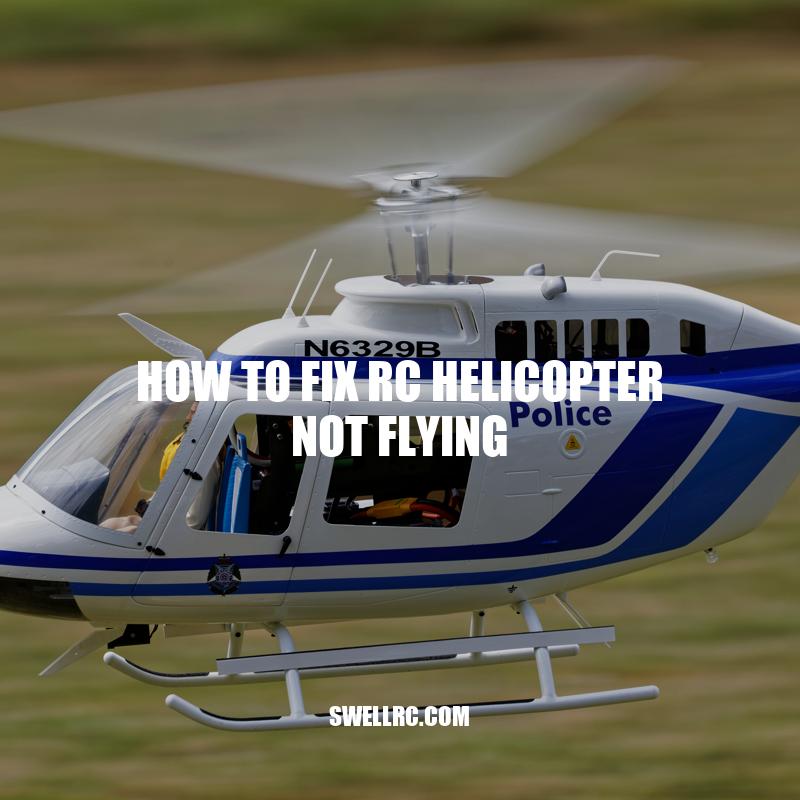Troubleshooting RC Helicopter: Fixes for not Flying
RC helicopters are exciting and fun toys to play with, but they can be frustrating when they don’t work as expected. RC helicopter enthusiasts know that there can be many reasons why an RC helicopter is not flying. It could be a dead battery, loose connectors, damaged rotor blades, or interference in the radio signal. Whatever the case may be, fixing an RC helicopter requires patience and diligence. In this article, we will explore some of the common reasons why an RC helicopter may not fly and provide troubleshooting tips to help you fix the issue. Whether you’re a beginner or an advanced RC helicopter pilot, these tips will help you get your helicopter back in the air in no time. Before we dive into the troubleshooting tips, let’s take a closer look at the different types of RC helicopters and the components that make them fly.
Types of RC Helicopters and their Components
RC helicopters come in different types, including micro, mini, and larger size helicopters. All types of RC helicopters have the following components:
- Frame: This holds all the components together and provides the structural support for the helicopter.
- Main rotor assembly: This produces lift for the helicopter by spinning the blades.
- Tail rotor assembly: This helps to counteract the torque produced by the main rotor assembly.
- Battery: This provides the power to the motor and electronics.
- Motor: This converts the electrical power from the battery into rotational power.
- Electronic speed controller (ESC): This controls the speed of the motor.
- Radio transmitter: This sends the control signals to the helicopter.
- Receiver: This receives the control signals from the transmitter and sends them to the ESC and servos.
- Servos: These are responsible for controlling the different movements of the helicopter, such as pitch and yaw.
With a basic understanding of the components, we can now troubleshoot common issues when an RC helicopter is not flying. If you’re having trouble with your RC helicopter, don’t worry – there are many resources available to help you get started. Online forums and instructional videos can provide helpful tips and tricks for fixing your helicopter. Additionally, there are many stores that sell replacement parts and tools for repairing RC helicopters.
What are the components of a helicopter?
A helicopter is a complex flying machine that consists of various components. Here are some of the key parts:
- Rotors: The rotors of a helicopter are what provide lift and allow it to fly. There are typically two or more rotors on a helicopter, which spin in opposite directions.
- Engine: The engine of a helicopter is responsible for powering the rotors and providing thrust.
- Transmission: The transmission of a helicopter helps to transfer power from the engine to the rotors.
- Cockpit: The cockpit is where the pilot sits and controls the helicopter. It typically includes a control stick, pedals, and various instruments.
- Fuselage: The fuselage is the main body of the helicopter, which provides space for the crew, passengers, and cargo.
If you are interested in learning more about helicopters, check out websites like Vertical Magazine and products like the Helicopters 1000-Piece Puzzle.
Steps for Fixing an RC Helicopter that Won’t Fly
When your RC helicopter is not flying, there are several things you can do to troubleshoot and get it back up in the air. Here are some steps you can follow:
| Steps | Details |
|---|---|
| Step 1: Check the battery and transmitter | Ensure that the battery is fully charged and the transmitter is not experiencing any interference or dead batteries. |
| Step 2: Check the blades | Verify that the blades are straight, balanced, and not damaged or warped. Replace or reshape any damaged blades. |
| Step 3: Check the motor | Inspect for any damage or signs of wear, and replace or repair if necessary. |
| Step 4: Check the gears | Ensure that the gears are properly aligned and not damaged, and replace or repair if needed. |
| Step 5: Test and adjust | After fixing any issues, test your helicopter to see if it’s flying correctly. If not, adjust and make any necessary changes. |
By following these steps, you can troubleshoot common issues with your RC helicopter and get it back in the air. However, some issues may require more advanced technical knowledge or professional assistance. If you’re unsure about how to repair your RC helicopter, it may be best to seek the help of an experienced technician. Online websites and service providers like HobbyKing, MotionRC, and RC Planet are some of the best resources for RC helicopter tools, parts, and accessories.
Why Won’t My RC Helicopter Fly?
There could be several reasons why your RC helicopter won’t fly, including:
- The battery may not be charged or installed properly
- The controls may not be calibrated correctly
- The weight balance of the helicopter may be off
- The rotor blades may be damaged or need to be replaced
- There could be interference from other electronics, like Wi-Fi or Bluetooth signals
If you’re experiencing issues with your RC helicopter, consult the user manual or contact the manufacturer for troubleshooting advice. Additionally, there are many online forums and YouTube channels dedicated to RC helicopter enthusiasts that may provide helpful tips and tricks.
Tips for Maintaining an RC Helicopter
Preventative maintenance can help extend the life of your RC helicopter and minimize the chance of issues that can cause it not to fly. Here are some tips for maintaining your RC helicopter:
1. Keep it clean and dry
– Remove dust, dirt, and debris regularly
– Use compressed air to blow out any excess debris or dust
– Store your RC helicopter in a dry and clean environment
2. Follow the manufacturer’s instructions
– Read and follow the manufacturer’s instructions on using and maintaining your RC helicopter
– Use the right tools and accessories recommended by the manufacturer
– Follow the recommended maintenance schedule
3. Inspect and replace parts regularly
– Check the blades, motor, gears, and other components regularly for signs of damage or wear
– Replace any damaged or worn-out parts immediately
– Keep a spare set of essential parts in case of emergency
4. Charge the battery correctly
– Use the right charger according to the manufacturer’s instructions
– Avoid overcharging or undercharging the battery
– Store the battery in a safe and dry place when not in use
By following these tips, you can help prevent your RC helicopter from not flying and ensure that it stays in top condition. RC enthusiasts can also find useful videos and tutorials on YouTube and specialized forums like Helifreak, RC Groups, and RC Universe.
How do you clean an RC helicopter?
Here are the steps you can follow to clean an RC helicopter:
- Remove the battery and disconnect it from the helicopter.
- Use a soft-bristled brush or compressed air to remove any dust or dirt from the helicopter.
- If there are any tough stains or dirt, use a damp cloth with some mild soap to clean it.
- Make sure all the components are completely dry before reconnecting the battery and flying the helicopter.
Remember that regular cleaning can help extend the lifespan of your RC helicopter. For more information and products on RC helicopters, check out websites like horizonhobby.com or rcplanet.com.
Common Mistakes to Avoid with RC Helicopters
Even the most experienced RC helicopter pilots can make mistakes that can cause their helicopter not to fly. Here are some common mistakes you should avoid:
1. Flying in poor weather conditions
– Wind, rain, and other poor weather conditions can cause issues with flying
– Wait for clear and calm weather to fly your RC helicopter
2. Attempting advanced maneuvers without enough practice
– Advanced maneuvers require experience and practice
– Start with basic maneuvers, and gradually progress to advanced ones
3. Ignoring the battery level
– Check the battery level before each flight
– A low battery can cause your helicopter to crash or not fly at all
4. Overestimating the helicopter’s capabilities
– Know the limitations of your helicopter
– Don’t attempt maneuvers that your helicopter is not capable of
There are many online resources for RC helicopter enthusiasts and pilots, including forums and websites like RC Groups, Helifreak, and RC Universe. You can find helpful information, tips, and tricks about maintaining and troubleshooting your RC helicopter. You can also find new and upgraded parts for your RC helicopter on websites like Amazon, eBay, and many hobby stores. Keeping your RC helicopter in good condition and avoiding common mistakes can help you enjoy your hobby safely and have a great flying experience.
Why Won’t My RC Helicopter Fly Straight?
There are several reasons why your RC helicopter may not fly straight, such as:
- Uneven or damaged rotor blades
- Unbalanced weight distribution
- Incorrect gyro settings
- Wind or other environmental factors
To troubleshoot the issue, check the rotor blades for any damage or unevenness, adjust the weight distribution by adding or removing weights, and ensure the correct gyro settings are programmed. If the problem persists, consult the manufacturer’s instructions or reach out to their customer support for further assistance.
If you’re in the market for a new RC helicopter, consider checking out reputable websites or products that have high ratings and positive reviews to ensure you’re getting a reliable and quality product.
Conclusion
RC helicopters are fascinating and exciting machines to fly. However, they can be frustrating when they don’t work as expected. If you encounter problems with your RC helicopter not flying, there are several things you can do to troubleshoot and fix the problem. Remember to check the battery, blades, motor, and gears. Avoid common mistakes such as flying in poor weather conditions, attempting advanced maneuvers without enough practice, ignoring the battery level, and overestimating the helicopter’s capabilities. Use online resources and websites to find tips, tricks, and new parts for your RC helicopter. Above all, enjoy your hobby and have a great flying experience!



